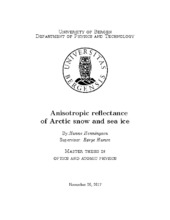Anisotropic reflectance of Arctic snow and sea ice
Master thesis
Permanent lenke
https://hdl.handle.net/1956/17240Utgivelsesdato
2017-12-21Metadata
Vis full innførselSamlinger
Sammendrag
We present an investigation of the angular distribution of reflected light on snow and sea ice, for three selected wavelengths; 500, 800 and 1100 nm. Our analysis covers how the angular reflectance distribution is affected by varying the solar zenith angle and cloud configuration, and also if snow grain size and snow thickness will has an influence. We have mainly addressed snow reflective properties, as snow is a key player in the earth’s radiation budget. With an accurate radiative transfer simulation tool (AccuRT), we have simulated various cloud, snow and sea ice scenarios. Our main conclusion is that neither snow or sea ice seems to reflect light isotropically over the upper hemisphere, and that the presence of even thin clouds contribute to extensively to the diffusing of light. The effect is most prominent for 500 nm light, while for longer wavelengths the diffusing effect happens at a slower rate, leaving detectable signals on small cloud variations. For a typical cloud configuration, a cloud thickness of more than 100 m will diffuse the incident light to an extent where we can not distinguish the incident solar angle based on angular distribution plots. In April 2016 we collected spectral radiation data on three different locations on the arctic archipelago of Svalbard. This data has been assessed in light of the modelled results, proving to support our hypothesis of the wavelength dependency of the clouds diffusing effects. We found that a thicker cloud cover will shift the detected average angle of the incident light towards the average polar angle (45◦).
